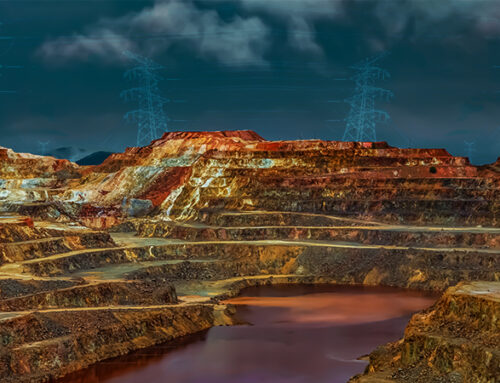Energy storage is seen by some as the Holy Grail of the energy markets, providing a low-carbon alternative to conventional generation for balancing systems with increasing levels of intermittent renewable generation. Over a series of posts, I will explore some of the technologies under development and assess the relative strengths and weaknesses of the various projects.
Electricity cannot be stored in a meaningful way (excluding capacitors which are inefficient and very short in duration), so energy is normally stored in a potential form, as chemical potential energy in batteries and stockpiles of coal and stored gas, and gravitational potential energy in pumped hydro.
There are essentially two breeds of energy storage under development: grid storage solutions, and behind-the-meter systems. In this first post I’d like to start big, with the technology which claims to have the potential for large-scale grid level applications: compressed air energy storage (“CAES”).
Compressed air energy systems
The first air compressors were bellows used for metallurgy as far back as 2000 B.C. In the late 19th century some cities such as Paris, Birmingham and Buenos Aires had compressed air grid systems in place, initially to power clocks by providing a pulse of air every minute, but later to deliver power to homes and industry. By 1896 Paris had a 30-mile wide 80 psi compressed air system powered by over 3000hp of compressed air equipment, and it was expected by some that compressed air would take over from electricity as a cleaner energy source.
The first CAES system was constructed at Huntorf in Germany, with a capacity of 290 MW. The plant runs in a daily cycle with 8 hours of compressed air charging and 2 hours of expansion. It has achieved high levels of performance with 90% availability and a round-trip efficiency of 42%.1, 2
A 110 MW plant with a capacity of 26 hours was built in McIntosh, Alabama in 1991, at a cost of USD 65 million, which equates to USD 590 / kW of generation capacity and USD 23 / kW-hr of storage capacity. The plant is capable of delivering its full power output for up to 26 hours. The major improvement relative to the Huntorf facility is the installation of a heat recuperator that re-uses part of the waste heat, reducing fuel consumption by 22-25% and increasing efficiency to about 54%. The plant has also demonstrated high levels of availability, over 90%.1, 2, 3
Currently a number of other projects are under consideration, including a 1,200 MW CAES project at Intermountain in Utah, with a 48-hour duration.
CAES facilities consist of compressed air which is stored in large underground cavities, which is released when needed and used to turn turbines that generate electricity. They utilise an open-cycle natural gas-fired combustion turbine, without compressor blades, which are not required because the air has already been compression on injection into the cavity.

The compression of air generates heat, much of which is dissipated as waste in the current CAES installations. When the stored air is later expanded, its temperatures drops significantly, so secondary heat must be applied, typically using natural gas to warm the air. This heat loss impacts the cost-effectiveness of CAES technology, and generates emissions. For example, the Alabama plant has an efficiency in the compression phase of 82%, whereas the expansion phase requires combustion of natural gas at one third the rate of a gas turbine producing the same amount of electricity.
Lessons from Iowa
In 2003, preliminary analysis was started for a USD 400 million, 270 MW CAES project at Des Moines, Iowa (“ISEP”). The project was ultimately cancelled as studies found the geology was unsuitable, and the United States Department of Energy commissioned a comprehensive report from Sandia National Laboratories to study the lessons from the project.
The study reviewed the analysis carried out by the project sponsors, which illustrated that the owner’s in-service capital cost for a CAES facility like ISEP would be about 20% higher than a comparably sized, conventional natural gas-fired combined-cycle electric generation facility, while the fixed and variable O&M costs and environmental emissions rates would be broadly similar.
A CAES facility would be operationally more flexible than a conventional generation alternative, with an ability to ramp up and down faster and in a linear manner, a better ability to accommodate multiple daily start-ups and shutdowns, and a lower minimum load level, in addition to the ability to store electricity. A CAES facility would also have a significantly better heat rate (better fuel efficiency) in generation mode resulting in lower fuel use during the generation cycle, and therefore lower emissions.
Including both intrinsic and extrinsic value, the CAES unit was found to have a higher total US$/kW value than the conventional generation alternatives in all scenarios studied. However, the CAES option also had a higher capital cost, meaning that while the lifetime net present value of the CAES facility was positive, it was comparable to that of the conventional alternatives.
IESP | CCGT | OCGT |
|
|---|---|---|---|
| Intrinsic value | 1,713 | 1,696 | 1,281 |
| Extrinsic value | 473 | 264 | 190 |
| Total value | 2,186 | 1,960 | 1,471 |
| Cost | 1,547 | 1,205 | 805 |
| Net value | 639 | 755 | 666 |
Scenario analysis in a high fuel (gas and coal) price environment, found that the net benefit of the CAES alternative moved closer to that of the combined cycle unit, and exceeded that of the combustion turbine, due to its higher fuel efficiency. In this sense, a CAES unit like ISEP would represent a hedge against increasing future fuel prices.
The study found that the nature of the project owner would be a critical factor to the success of a CAES installation, as this will affect whether the owner will be able to extract all potential revenue streams. An entity that dispatches its own resources, would see more benefits if they also owned or had contractual access to sources of renewable generation. The nature of the market is also important, driving income from tariffs and other market mechanisms.
Value drivers include the peak/off-peak price spread arbitrage in addition to a number of other sources of value, including:
- The option value associated with price and quantity variability (extrinsic value);
- Ancillary services due to the ability to ramp quickly and operate with multiple daily startups/shutdowns;
- 100% dispatchability of off-peak load which can improve capacity factors and reduce cycling of conventional plants, and reduce curtailment of renewable resources;
- Ability to enable more renewable resources than could be accomplished without storage;
- Transmission investment deferral, as storage can absorb intermittent renewable energy when it is available and the transmission system is constrained.
The study also found that traditional resource planning models used by utility planners would not generally capture the full benefits of a CAES installation, as they are not designed to evaluating the storage component.
Adiabatic storage plants
The next generation of CAES plants is likely to include the ability to store the heat generated in the compression phase…known as “adiabatic CAES”. This would remove the need for gas-fuelled heating of the air on extraction, reducing both cost and emissions. Such a system is estimated to be up to 70% efficient.
Heat storage systems with an ability to operate at up to 600oC would be required. There are a number of lines of development, all of which are based on technologies already seen in a number of industrial applications, including solid stores made of ceramic, stone, concrete or cast iron, fluid-based heat exchangers, and packed-bed systems. Further development of compressors and air turbines would also be required for high-temperature operation.

In their 2015 study, Barbour5 et al outlined a number of research projects in the field of adiabatic CAES:
“Recent research in A-CAES includes the ongoing EU based “Project ADELE” being undertaken by RWE Power, General Electric, Züblin and DLR, which quotes the expected efficiency at 70%6. Garrison and Webber7 present a novel design for an integrated wind-solar-A-CAES system which uses solar energy to re-heat the compressed air before expansion, with an overall energy efficiency of 46%. Pimm et al.8 describe a novel approach in which “bags” of compressed air are stored under the sea; the air storage is essentially isobaric as the pressure is determined by the depth. Garvey9 presents an analysis of a large-scale integrated offshore-wind and A-CAES system using these energy bags. This approach is also being investigated by Cheung et al.10 in partnership with Hydrostor11. Commercial companies Lightsail12 and SustainX13 are developing near-isothermal CAES but their technologies are yet to reach the market so details on the processes and performances are scarce.”
An adiabatic CAES scheme developed by North American storage companies, General Compression and NRStor is being considered at Ontario in Canada (“GCAES”). A prototype of this system is currently in operation in Gaines, Texas, which uses a 2-MW wind turbine to power injection of compressed air into an underground salt cavern. The GCAES system captures the heat produced by compression and channels it into a water storage pond. The heat stored in the pond is then used to warm the released air during the generation cycle, which provides for greater energy from the expanding air and prevents the equipment from freezing.
As the compressors are powered by wind, the system provides a source of fuel-free energy storage and power generation. Early calculations by the sponsors suggest that the installed cost of long-duration storage is as little as one-tenth that of lithium-ion battery storage.
NRStor partnered with a professor at Washington State University to create a model of Ontario’s power system to analyse the potential of integrating GCAES. They found that by reducing the need for peaking plants, a 1,000 MW CAES facility could generate savings of CAD 2.5 billion over 20 years. Under the most likely supply and demand scenarios, the model showed that using a GCAES for a combination of wind integration and load leveling would deliver between CAD 6.5 billion and CAD 8.3 billion in reduced costs to ratepayers over the 20-year life of the facility. These potential savings exceed the authors’ expectations of the costs of such a CAES facility (which are not quantified in their paper).
Could CAES challenge pumped hydro?
A 2015 report from Energy Storage Update suggested that CAES could offer a cost-effective bulk storage option and could challenge pumped-hydro storage as the dominant bulk energy storage technology going forward.
Based on the projects evaluated by Energy Storage Update, the range of estimated cavern development costs could vary significantly from between 10% and 75% of total project costs depending on the difficulty of the underground geology.
Current CAES costs range between USD 1,600-2,200 / kWh, with storage equipment making about two thirds of the CAPEX, followed by cavern costs (10-25%), EPC services (10%), BOP (7%), gas line (4%) and substation/transmission line (about 3%). This compares with USD 1,200 – 2,100 / kWh for pumped storage.
A comparison of various storage technologies by the Scottish Government carried out in 2010 also found that CAES and pumped hydro would be economically comparable:
| Technology | Capacity (MWh) | Cost (£/kWh) | Rating (MW) | Efficiency | Status | Lifetime |
|---|---|---|---|---|---|---|
| Pumped hydro | <1,000 | 500 - 2,000 | 100 - 5,000 | 70 - 79% | Mature | >20 years |
| CAES | 100- 1,000 | 500 - 600 | 5 - 300 | 70- 79% | Mature | 20 - 40 years |
| Cryogenic storage | 10 - 100 | 50 - 500 | 0.5 - 10 | 40 - 50% | Prototype testing phase | 20 - 40 years |
Traditional CAES is a mature and reliable technology, but its lack of deployment points to the difficulties of finding suitable sites at a cost that justifies the low round-trip efficiency levels, as illustrated by the Iowa project. Adiabatic CAES shows some promise, and there are a number of studies and trials underway, however, there are significant technological challenges to overcome. Ultimately, if the technology can be proven, CAES could become a meaningful contributor to the grid-level bulk storage toolkit, but like pumped hydro, it’s deployment will rely on the presence of suitable geological formations.
1. Succar S, Williams RH. Compressed air energy storage: theory, resources, and applications for wind power. Technical report,
Energy Systems Analysis Group, Princeton Environmental Institute, Princeton University; 2008.
2. Chen H, Cong TN, Yang W, Tan C, Li Y and Ding Y. Progress in electrical energy storage system: A critical review. Progress in
Natural Science, 2009; 19:291-312
3. Samir S. Large energy storage systems handbook. Levine G editor. CRC Press; 2011, p 112-152
4. Luo, Xing, Wang, Jihong, Dooner, Mark, Clarke, Jonathan and Krupke, Christopher. (2014) Overview of current development in
compressed air energy storage technology. Energy Procedia, Volume 62 . pp. 603-611. ISSN 1876-
5. Barbour E, Mignard D, Ding Y, Li Y. Adiabatic Compressed Air Energy Storage with packed bed thermal energy storage. Applied
Energy, Volume 155, 1 October 2015, Pages 804–815
6. RWE power. ADELE – Adiabatic compressed air energy storage for electricity supply. http://www.rwe.com/web/cms/mediablob/en/391748/data/364260/1/rwe-power-ag/innovations/adele/Brochure-ADELE.pdf
7. J.B. Garrison, M.E. Webber. An integrated energy storage scheme for a dispatchable solar and wind powered energy system. J
Renew Sustain Energy, 3 (2011)[19]
8. A.J. Pimm, S.D. Garvey, M. de Jong. Design and testing of Energy Bags for underwater compressed air energy storage. Energy, 66 (2014), pp. 496–508
9. S.D. Garvey. The dynamics of integrated compressed air renewable energy systems. Renew Energy, 39 (2012), pp. 271–292
10. B.C. Cheung, R. Carriveau, D.S.K. Ting. Parameters affecting scalable underwater compressed air energy storage. Appl Energy,
134 (2014), pp. 239–247
11. Hydrostor.http://hydrostor.ca/home/
12. Lightsail Energy.http://www.lightsail.com/
13. SustainX smarter energy storage.http://www.sustainx.com/.






Leave A Comment